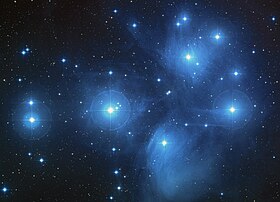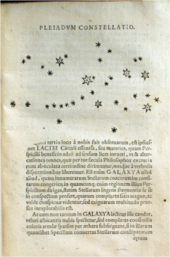Pleiades
| Pleiades | |
|---|---|
 | |
| Observation data (J2000 epoch) | |
| Constellation | Taurus |
| Right ascension | 03h 47m 24s[1] |
| Declination | +24° 07′ 00″[1] |
| Distance | 444 ly on average[2][3][4][5] (136.2±1.2 pc) |
| Apparent magnitude (V) | 1.6[6] |
| Apparent dimensions (V) | 110' (arcmin)[6] |
| Physical characteristics | |
| Other designations | Seven Sisters,[1] M45,[1] Cr 42,[1] Mel 22[1] |
The Pleiades (/ˈpliː.ədiːz, ˈpleɪ-, ˈplaɪ-/),[7][8] also known as The Seven Sisters, Messier 45, and other names by different cultures, is an asterism and an open star cluster containing middle-aged, hot B-type stars in the north-west of the constellation Taurus. It is among the star clusters nearest to Earth, it is the nearest Messier object to Earth, and is the cluster most obvious to the naked eye in the night sky.
The cluster is dominated by hot blue and luminous stars that have formed within the last 100 million years. Reflection nebulae around the brightest stars were once thought to be left over material from their formation, but are now considered likely to be an unrelated dust cloud in the interstellar medium through which the stars are currently passing.[9]
Computer simulations have shown that the Pleiades were probably formed from a compact configuration that resembled the Orion Nebula.[10] Astronomers estimate that the cluster will survive for about another 250 million years, after which it will disperse due to gravitational interactions with its galactic neighborhood.[11]
Together with the open star cluster of the Hyades, the Pleiades form the Golden Gate of the Ecliptic.
Origin of name[]
The name of the Pleiades comes from Ancient Greek, Πλειάδες.[12] It probably derives from plein ("to sail") because of the cluster's importance in delimiting the sailing season in the Mediterranean Sea: "the season of navigation began with their heliacal rising".[13] However, in mythology the name was used for the Pleiades, seven divine sisters, the name supposedly deriving from that of their mother Pleione and effectively meaning "daughters of Pleione". In reality, the name of the star cluster almost certainly came first, and Pleione was invented to explain it.[14]
Folklore and mythology[]


The Pleiades are a prominent sight in winter in the Northern Hemisphere, and are easily visible out to mid-Southern latitudes. They have been known since antiquity to cultures all around the world,[16] including the Celts (Welsh Tŵr Tewdws [Tur Toodus], Irish "Streoillín"), Hawaiians (who call them Makaliʻi[17]), Māori (who call them Matariki), Aboriginal Australians (from several traditions), the Persians, whence in Hindi and Urdu (who called them پروین Parvīn or پروی Parvī),[18] the Arabs (who called them الثريا al-Thurayya[19]), the Chinese (who called them 昴 mǎo), the Quechua, the Japanese (who call them 昴 / スバル Subaru), the Maya, the Aztec, the Sioux, the Kiowa,[20][21] and the Cherokee. In Hinduism, the Pleiades are known as Krittika and are associated with the war-god Kartikeya. They are also mentioned three times in the Bible.[22][23]

The earliest-known depiction of the Pleiades is likely a Northern German Bronze Age artifact known as the Nebra sky disk, dated to approximately 1600 BC.[24] The Babylonian star catalogues name the Pleiades MULMUL (